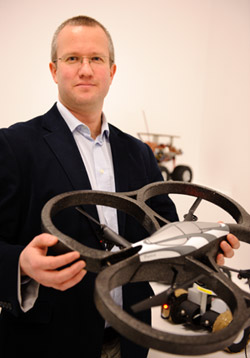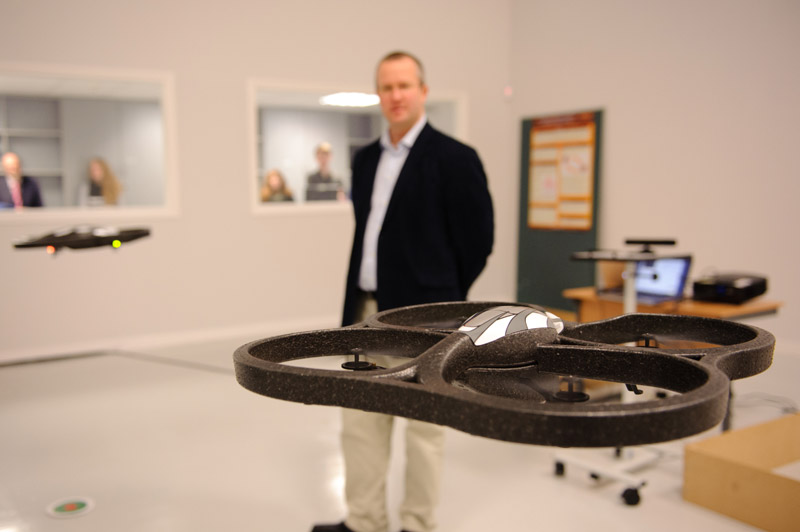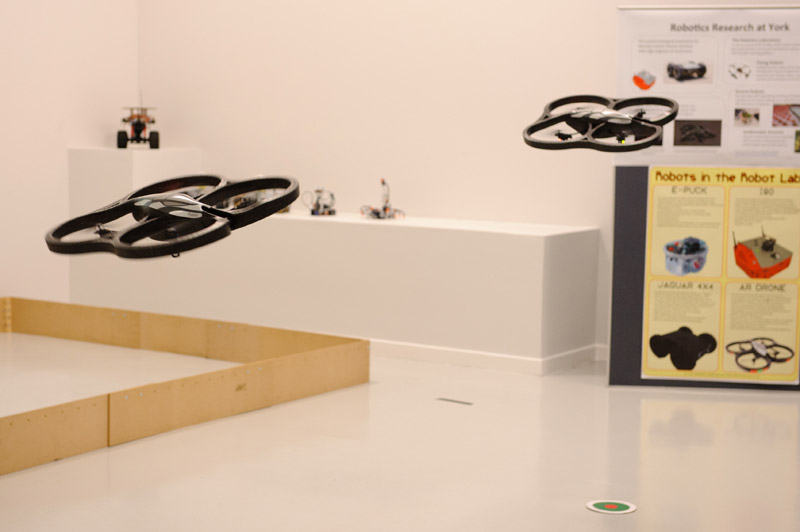York robots swarm at official opening

Flying and land-based robots were the stars of the launch of the University's new £250,000 robotics laboratory.
The six metre high laboratory, part of the Department of Computer Science on the superb £750 million campus expansion at Heslington East, provides an ideal base to develop and test swarm robotic systems - small, self-repairing robots.
Our research is concentrating on developing biologically-inspired control systems for lots of small, inexpensive robots working together in swarms
Professor Jon Timmis
Swarm robotics could potentially play a vital role in future planetary and deep sea exploration, as well as search and rescue operations. For example, groups of small, inexpensive robots could be used to search for aircraft black boxes following a disaster over water, or as part of search and rescue missions following natural disasters. Teams of robots could cover more ground than one large robot, and should one breakdown, the rest of the group could continue the operation.
York’s research into swarm robotics is led by Professor Jon Timmis who has received a Royal Society Wolfson Research Merit Award for his research into self-healing swarm robotics systems, with funding for five years.
Researchers from the University’s Departments of Electronics and Computer Science are also collaborating on an EU-funded project, developing underwater swarm robotic systems which are capable of carrying out self-organising search and rescue tasks, and relaying information back to a base station.
The new laboratory is allowing researchers to test ideas in a controlled environment before moving into more challenging environments.
To mark the official launch of the robotics laboratory, Professor Timmis delivered a public lecture and demonstration of swarm robotics. Specially invited guests were given a tour of the new laboratory before the lecture.

Professor Timmis said: “Our research is concentrating on developing biologically-inspired control systems for lots of small, inexpensive robots working together in swarms. All the robots behave independently, but like a swarm of insects or our immune systems, the robots interact among themselves and alter their behaviour based upon the behaviour of others.
“Our aim is to develop systems to identify individual and collectively failing robots, diagnose what is wrong and then take corrective action to rectify the failure.”
The large 90 metre² arena can be split into smaller areas for research purposes and features a public viewing area, allowing school parties and visitors to watch experiments and research.
Development of the new £21 million Department of Computer Science building, which was officially opened last March, was supported by investment from the European Regional Development Fund (ERDF) in Yorkshire and the Humber, part of a major infrastructure project led by Science City York to extend the assets and strategic potential of York as a leading centre for science and innovation.
Professor John McDermid, Head of the University’s Department of Computer Science, said: “The new robotics laboratory provides us with a world-class facility at York, allowing us to foster the highest standards of academic excellence.
“Not only does it supply academics and students with a fantastic resource, but we are sure the robotics laboratory will capture the public’s imagination, inspiring more young people to follow a technical education.”
Image gallery
Further information




